
SaaS Customer Journey Mapping: A Comprehensive Guide 2024

by
Wiktoria Slowikowska
Oct 4, 2024
Identify and convert your most valuable users
Sign Up
Introduction

Customer journey mapping is a powerful tool that allows SaaS businesses to visualize and optimize every step of their customers' interactions with their product. But what exactly is customer journey mapping, and why is it particularly crucial in the SaaS context?
Customer journey mapping is the process of creating a visual representation of the entire experience a customer has with your product or service. It tracks their path from initial awareness through the consideration and purchase phases, to onboarding, adoption, and hopefully, long-term loyalty and advocacy. For SaaS businesses, this journey is often complex and multifaceted, involving numerous touchpoints across digital platforms.
The importance of journey mapping in the SaaS context cannot be overstated. Unlike traditional software, SaaS products are continuously evolving, with regular updates and feature releases. This ongoing relationship between the customer and the product means that the journey doesn't end at purchase—it's a continuous cycle of engagement, value delivery, and renewal decisions. Journey mapping helps SaaS companies understand and optimize this unique lifecycle.
The benefits of customer journey mapping for SaaS businesses are numerous and impactful:
Enhanced Customer Experience: By identifying pain points and moments of delight, companies can refine their product and support to better meet customer needs.
Improved Customer Retention: Understanding the factors that lead to churn allows businesses to proactively address issues and increase customer lifetime value.
Informed Product Development: Journey maps reveal how customers actually use the product, informing feature prioritization and development.
Aligned Teams: A shared visualization of the customer journey helps align marketing, sales, product, and customer success teams around common goals.
Personalized Marketing: Insights from journey mapping enable more targeted, relevant marketing at each stage of the customer lifecycle.
Increased Revenue: By optimizing the journey, businesses can identify upsell and cross-sell opportunities, driving expansion revenue.
In this guide, we'll dive deep into the process of creating and leveraging customer journey maps for SaaS businesses. Whether you're a startup looking to establish your first mapping process or an established company aiming to refine your approach, you'll find valuable insights to enhance your customer's journey and drive business success.
Understanding the SaaS Customer Journey

The SaaS customer journey stages are a unique and often complex path that users first encounter with your product to becoming loyal advocates. Understanding this journey is crucial for optimizing your product, marketing, and customer success strategies. Let's break down the key stages:
Pre-purchase stages
Awareness
This is where potential customers first become aware of your SaaS solution. They might be actively searching for a solution to a problem or stumble upon your product through various channels such as:
Content marketing (blog posts, whitepapers, webinars)
Social media presence
Paid advertising
Word-of-mouth referrals At this stage, it's crucial to clearly communicate your value proposition and how your product solves specific pain points.
Consideration
Once aware of your solution, potential customers enter the consideration stage. They're now evaluating your product against competitors and alternatives. Key activities in this stage include:
Comparing features and pricing
Reading reviews and case studies
Engaging with your content (e.g., detailed product guides, comparison sheets)
Possibly signing up for a free trial or demo Your goal here is to provide comprehensive information and showcase your product's unique benefits.
Decision
This is the critical stage where prospects decide whether to purchase your SaaS product. Factors influencing this decision include:
Perceived value vs. cost
Ease of implementation
Customer support quality
Contract terms and flexibility Clear pricing information, responsive sales support, and easy purchasing processes are crucial at this stage.
Post-purchase stages
Onboarding
This is the customer's first hands-on experience with your product. A smooth onboarding process is critical for long-term success. Key elements include:
Interactive tutorials or walkthroughs
Personalized setup assistance
Clear documentation and resources The goal is to help customers achieve their first "win" or value realization as quickly as possible.
Adoption
In this stage, customers start integrating your product into their regular workflows. Focus areas include:
Encouraging use of core features
Providing ongoing education and best practices
Monitoring usage patterns to identify at-risk customers
Offering proactive support and guidance. The aim is to make your product an indispensable part of the customer's operations, fostering ongoing customer engagement and satisfaction.
Retention
Keeping customers engaged and satisfied is crucial in the SaaS model. Key retention strategies include:
Regular check-ins and business reviews
Continuous value demonstration
Responsive customer support
Gathering and acting on feedback
Providing timely updates and improvements. The goal is to continuously prove the value of your product and maintain high customer satisfaction.
Expansion
This stage focuses on growing the account through upselling or cross-selling. Activities might include:
Introducing advanced features or higher-tier plans
Suggesting additional products or services
Expanding usage to other departments or teams The key is to align expansion opportunities with the customer's growing needs and realized value.
Advocacy
The final stage is turning satisfied customers into active promoters of your product. Strategies include:
Implementing referral programs
Requesting testimonials and case studies
Engaging customers in user communities or advisory boards
Featuring customer success stories in your marketing. Advocates can become a powerful force for organic growth and credibility building.
Customer loyalty can become a powerful force for organic growth and credibility building.
Understanding these stages allows SaaS companies to create more targeted strategies and improve the overall customer experience. By recognizing distinct customer segments, you can tailor your approach to meet the varied needs of each group.
This ensures that your product resonates more deeply with different users, ultimately enhancing customer loyalty. Additionally, focusing on the customer lifetime value helps prioritize which segments to nurture and develop further.
Regularly updating your customer journey map provides insights into opportunities for improvement, ensuring a continually optimized experience. In the context of a B2B customer journey, these insights become even more crucial, as the decision-making process often involves multiple stakeholders and longer sales cycles.
Steps to Create a SaaS Customer Journey Map
1. Define Your Customer Personas
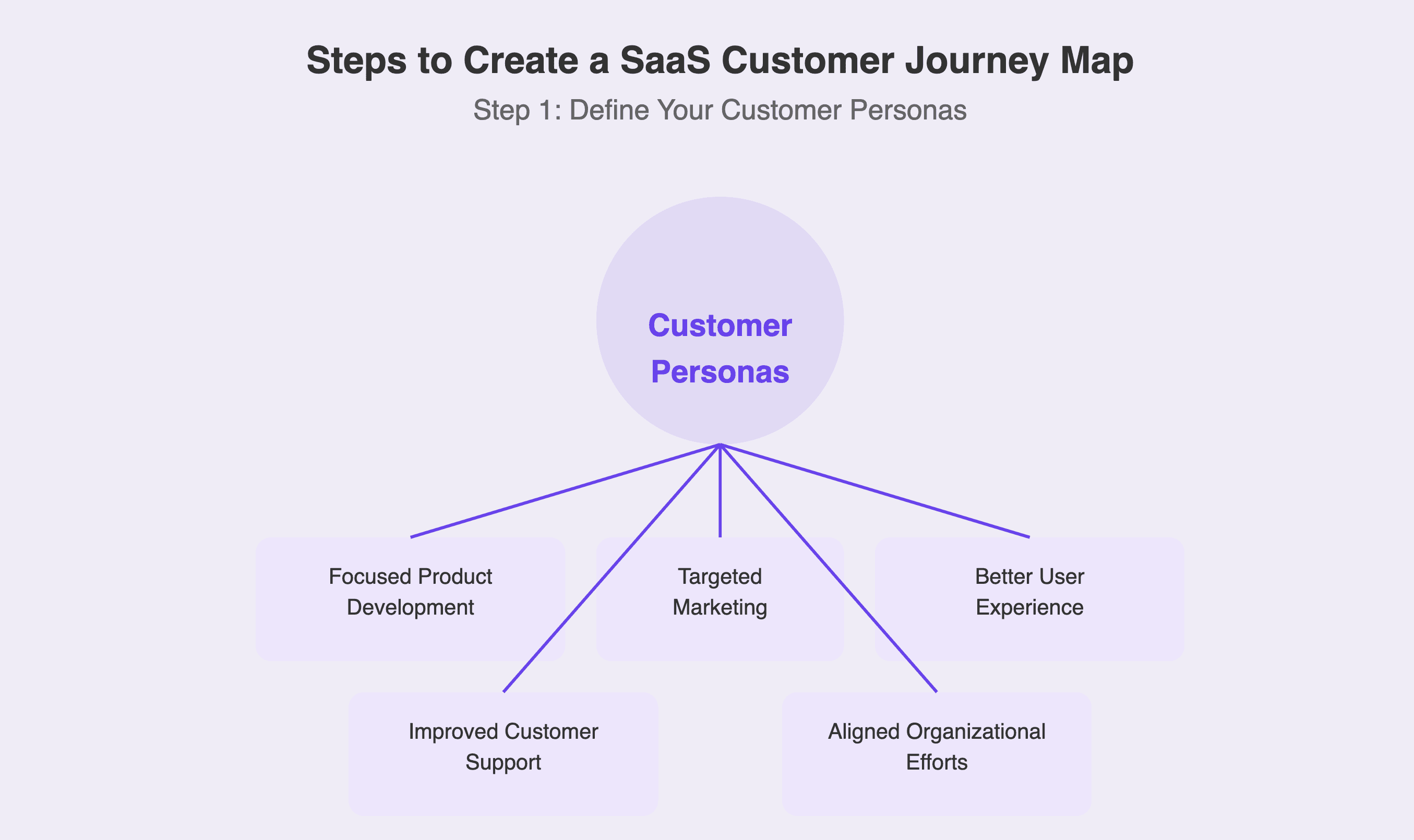
Buyer personas are vital in SaaS for several reasons:
Focused Product Development: They help prioritize features that truly matter to core users.
Targeted Marketing: Personas enable more effective, personalized marketing campaigns.
Better User Experience: They guide UX/UI decisions to align with user expectations.
Improved Customer Support: Support teams can provide more empathetic assistance.
Aligned Organizational Efforts: Personas create a shared understanding across all teams.
How to create SaaS-specific personas:
Gather Data: Use surveys, interviews, support logs, and analytics.
Identify Patterns: Look for common traits and behaviors among users.
Define Key Attributes: Consider job roles, technical skills, company size, pain points, and software preferences.
Create User Stories: Develop narratives of how each persona interacts with your product.
Validate and Refine: Test personas against real user data and update as needed.
Example of a user persona: "Tech-savvy Marketing Manager Sarah"
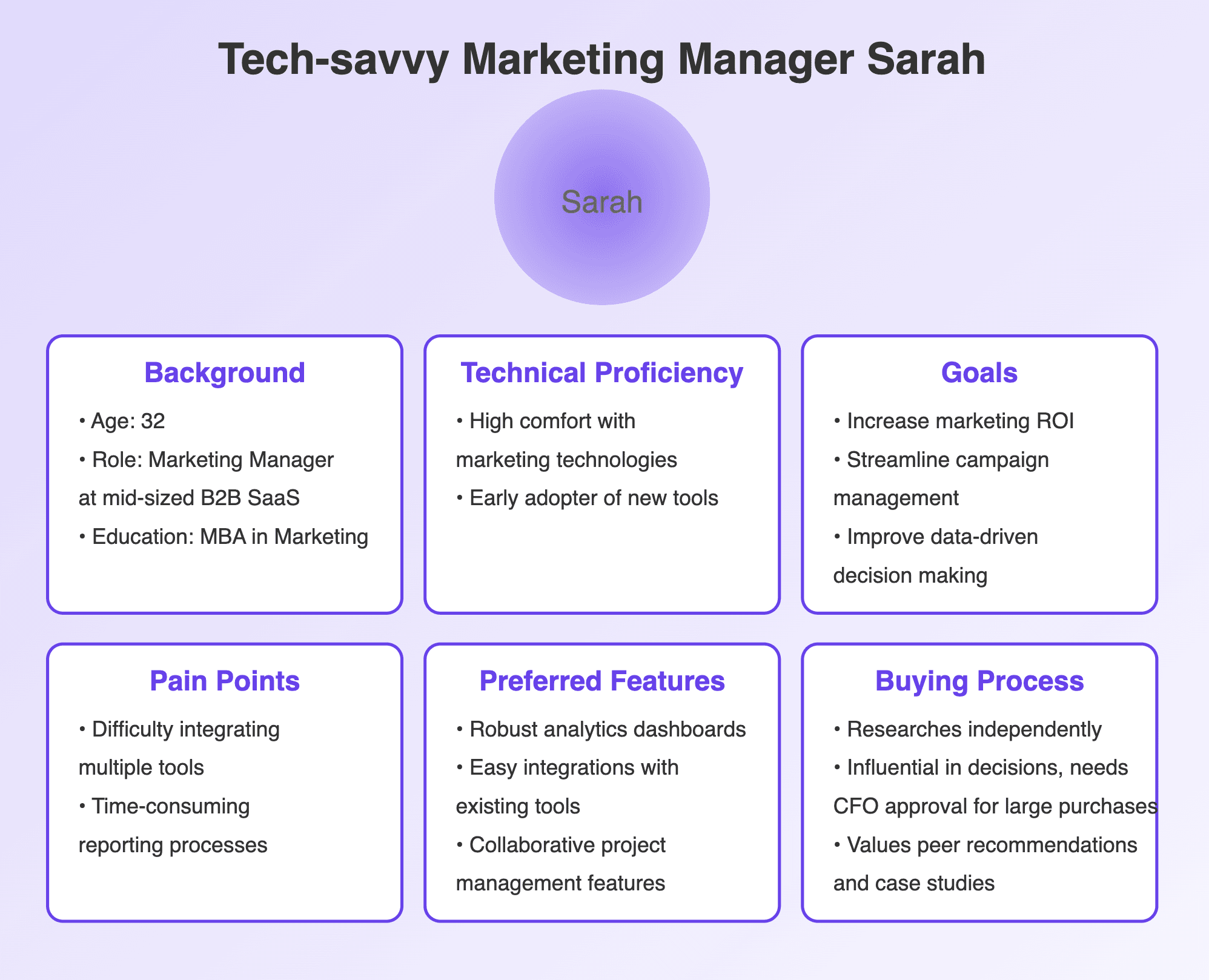
This persona helps tailor product features, marketing messages, and support to meet the needs of similar users, influencing decisions like prioritizing analytics features or creating content for mid-level marketing managers in B2B SaaS.
Additionally, understanding buyer personas allows you to identify what drives users to become loyal customers—those who consistently renew subscriptions, advocate for your product, and remain deeply engaged with its features over time.
2. Identify Customer Journey Touchpoints
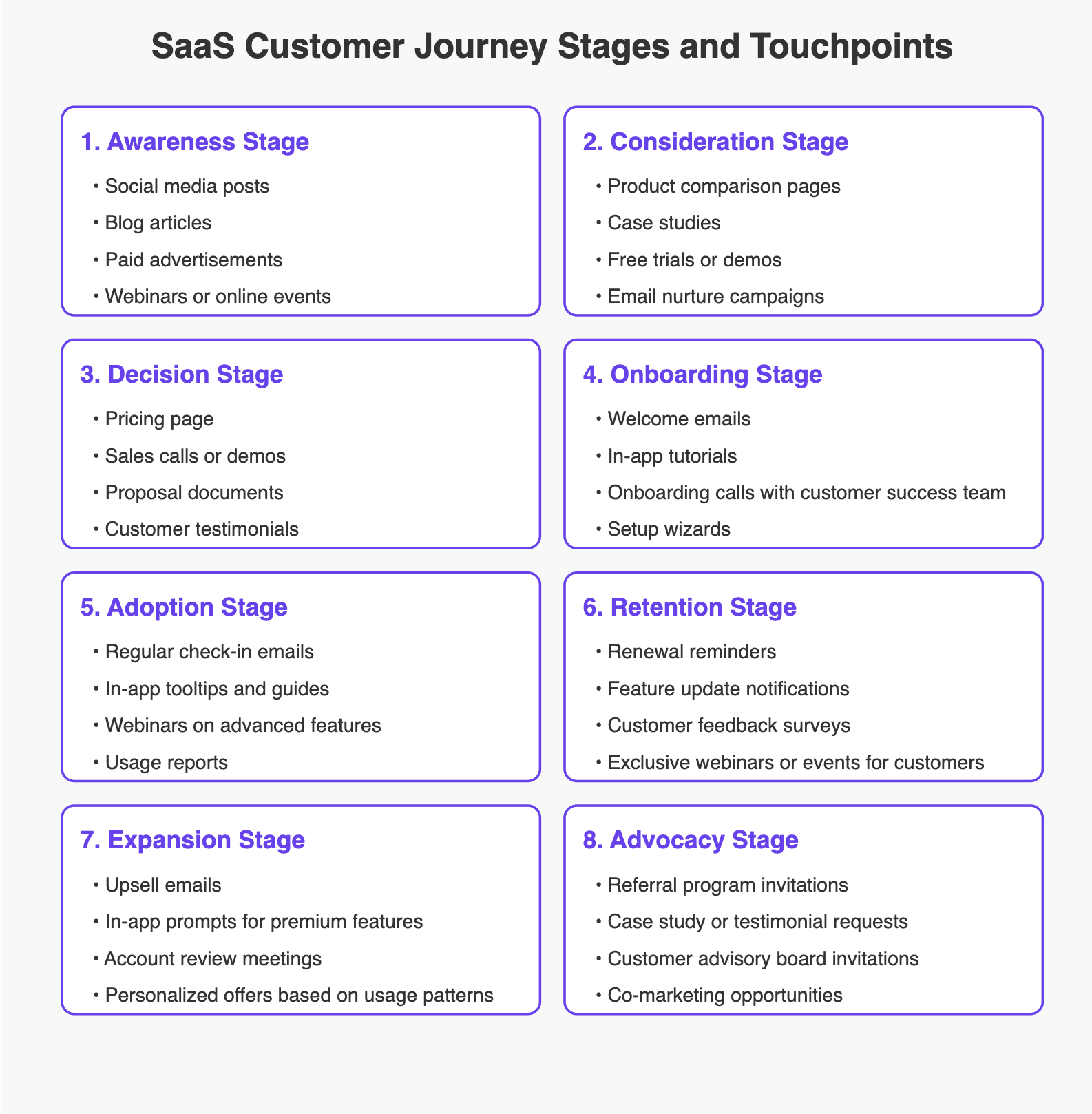
In the SaaS context, customer interactions are all the instances where a customer or potential customer interacts with your brand, product, or service. These interactions can be direct or indirect, digital or physical, and occur before, during, or after the actual use of your software. Touchpoints are critical in shaping the overall customer experience and play a significant role in the customer's decision-making process, directly impacting conversion rates.
To effectively map touchpoints to journey stages, consider the following approach:
Awareness Stage:
Social media posts
Blog articles
Paid advertisements
Webinars or online events
Consideration Stage:
Product comparison pages
Free trials or demos
Email nurture campaigns
Decision Stage:
Sales calls or demos
Proposal documents
Customer testimonials
Onboarding Stage:
Welcome emails
In-app tutorials
Onboarding calls with customer success team
Setup wizards
Adoption Stage:
Regular check-in emails
In-app tooltips and guides
Webinars on advanced features
Usage reports
Retention Stage:
Renewal reminders
Feature update notifications
Customer feedback surveys
Exclusive webinars or events for existing customers
Expansion Stage:
In-app prompts for premium features
Account review meetings
Personalized offers based on usage patterns
Advocacy Stage:
Referral program invitations
Case study or testimonial requests
Customer advisory board invitations
Co-marketing opportunities
When mapping touchpoints, it's crucial to consider both the timing and the context of each interaction. Some touchpoints may span multiple stages, and their impact may vary depending on the customer's specific journey. Additionally, using analytics tools can help you monitor these touchpoints, allowing you to gather data on customer interactions and make informed decisions about optimizing their experience.
To gain deeper insights, creating user journey maps can be incredibly beneficial. These visual representations help you understand how users interact with your SaaS product at each stage of their journey. By analyzing these maps, you can identify pain points and areas for improvement, ultimately enhancing user satisfaction and driving customer loyalty.
In conclusion, utilizing both touchpoint mapping and user journey maps enables you to create a comprehensive view of your customer experience. This dual approach empowers your team to make data-driven decisions, ultimately leading to a more effective strategy for customer retention, product adoption, and user satisfaction.
Remember, the goal is not just to list touchpoints, but to understand how they collectively shape the customer experience and influence the customer's progression through their journey with your SaaS product.
3. Map Customer Emotions
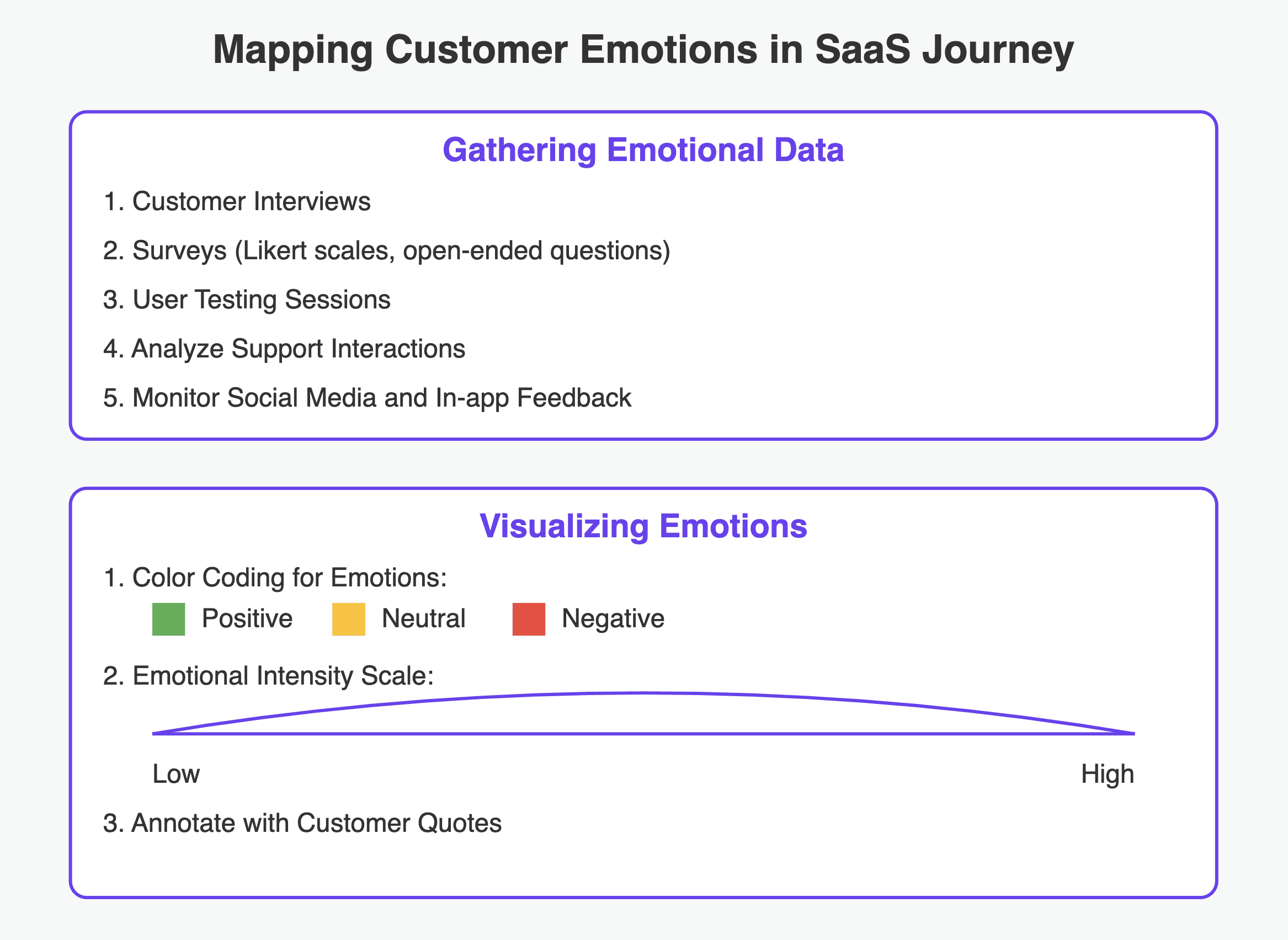
The emotional journey of customers plays a crucial role in SaaS. It directly impacts customer retention, product adoption, and brand loyalty. Understanding and addressing these emotions and customer behaviors throughout the buyer journey can lead to improved user experiences, more effective marketing strategies, and ultimately, a stronger connection between your customers and your product.
Techniques for gathering emotional data:
To gather emotional data effectively, combine qualitative and quantitative methods. Customer interviews provide deep, nuanced insights into emotional responses. Surveys with Likert scales and open-ended questions can capture both measurable data and personal experiences. User testing sessions, where you observe customers interacting with your product in real-time, can reveal immediate emotional reactions.
Don't overlook the wealth of emotional data in your existing channels. Analyze customer support interactions, social media comments, and in-app feedback. These sources often contain raw, unfiltered emotional responses that can be invaluable for your journey mapping.
Visualizing emotions on the journey map:
When it comes to visualizing emotions, aim for clarity and impact. A common approach is to use color coding, where different colors represent various emotional states. For instance, green might indicate positive emotions like satisfaction or excitement, while red could represent frustration or disappointment.
Consider using a simple emotional intensity scale alongside your journey stages. This could be a line graph that runs parallel to the main journey, showing emotional highs and lows. Annotate significant points with brief explanations or customer quotes to provide context.
4. Identify Customer Pain Points and Opportunities
Common pain points in SaaS customer journeys often include information overload during the research phase, complex onboarding processes, technical issues during regular use, feature limitations, integration challenges with existing tools, and confusing billing structures.
To discover these pain points, employ a mix of techniques. Conduct user testing sessions to directly observe customer struggles. Use surveys to gather both quantitative data and qualitative feedback from a broader audience. Analyze support tickets and chat logs for recurring issues. User behavior analytics can reveal where customers drop off or which features are underutilized.
Turning pain points into opportunities involves reframing each issue as a chance to enhance your product and customer experience. For instance, a difficult onboarding process could be transformed into an intuitive, guided experience. Feature limitations might inspire new development priorities. Confusing pricing could lead to a more transparent, flexible billing system.
Prioritize these opportunities based on their potential impact and feasibility. Some may be quick wins, while others might require longer-term development efforts. Remember, addressing pain points isn't just about fixing problems – it's about creating a smoother, more enjoyable customer journey that sets your SaaS product apart in a competitive market.
5. Analyze Current vs. Ideal State

Mapping the current journey involves documenting the actual experiences of your customers as they interact with your SaaS product. This includes all touchpoints, emotions, and pain points you've identified in previous steps. Use data from customer feedback, analytics, and internal insights to create an accurate representation of how customers currently move through their journey with your product.
Current State Mapping: Document actual customer experiences, touchpoints, and pain points
Envisioning and mapping the ideal journey requires some creative thinking. Imagine how your customer's experience could be if all pain points were resolved and every interaction was optimized. This ideal state should align with both customer needs and your business goals. Consider how emerging technologies or innovative approaches could enhance each stage of the journey.
Ideal State Envisioning: Creatively design an optimized journey addressing all pain points
Gap analysis between current and ideal states involves comparing these two journeys side by side. Identify the discrepancies at each stage - where does the current journey fall short of the ideal? These gaps represent your opportunities for improvement.
For example, if your current onboarding process takes several days but the ideal state is a seamless, same-day setup, that's a clear gap to address. Or if customers currently need to contact support frequently for common issues, but ideally they would have easy access to self-service solutions, that's another area for improvement.
Gap Analysis: Compare current and ideal states to identify improvement opportunities
Prioritize these gaps based on their impact on customer satisfaction and your business metrics. Some may require significant resources to address, while others might be quick fixes. Use this analysis to inform your product roadmap and customer experience initiatives, always keeping in mind the end goal of moving your current state closer to the ideal.
6. Customer Journey Mapping Process
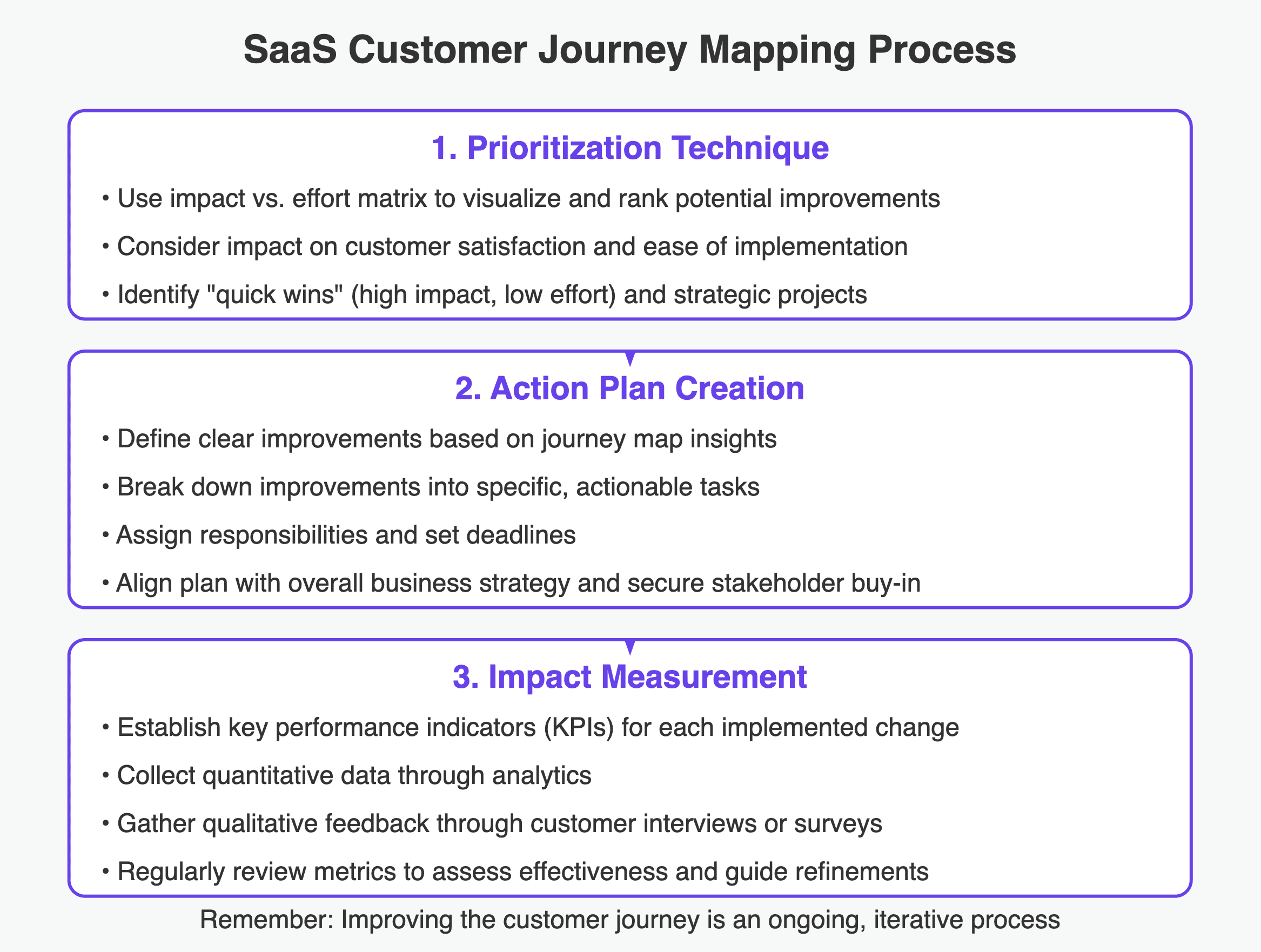
Techniques for prioritizing improvements often involve balancing the potential impact of changes against the effort required to implement them. Consider using a prioritization matrix that plots potential improvements on two axes: impact on customer satisfaction and ease of implementation. This visual approach can help you quickly identify "quick wins" (high impact, low effort) and strategic projects (high impact, high effort).
Prioritization Technique: Use an impact vs. effort matrix to visualize and rank potential improvements
Creating an action plan based on journey map insights requires translating your findings into concrete steps. Start by clearly defining the improvements you want to make. Then, break each improvement down into specific, actionable tasks. Assign responsibilities, set deadlines, and allocate necessary resources. Ensure your action plan aligns with your overall business strategy and has buy-in from key stakeholders across departments.
Action Plan Creation: Translate journey map insights into specific, actionable tasks with clear ownership and timelines
Measuring the impact of changes is crucial to validate your efforts and guide future improvements. Establish key performance indicators (KPIs) for each change you implement. These might include customer satisfaction scores, retention rates, time-to-value for new customers, or feature adoption rates. Collect both quantitative data through analytics and qualitative feedback through customer interviews or surveys. Regularly review these metrics to understand the effectiveness of your changes and identify areas that may need further refinement.
Impact Measurement: Set clear KPIs for each improvement and regularly collect both quantitative and qualitative data to assess effectiveness
Remember, improving the customer journey is an ongoing process. Use the insights gained from measuring the impact of your changes to continuously refine your understanding of the customer journey and inform future improvements. This iterative approach ensures your SaaS product continues to meet evolving customer needs and expectations.
Best Practices for SaaS Customer Journey Mapping
How do you create a journey map that truly captures your customer's experience? Here are five best practices to guide you:
1. Put Your Customer First
When mapping your customer's journey, it's easy to get caught up in your own processes and assumptions. Don't fall into this trap! Your map should reflect your customer's reality, not your company's internal view.
Pro tip: Listen to what your customers are saying and observe how they actually use your product. Their story is what matters here.
2. Let the Data Guide You
In the world of SaaS, we're swimming in data. Use it! But don't stop at just the numbers. Combine your quantitative analytics with qualitative customer feedback.
Think of it like this: analytics give you the bird's eye view, while customer feedback puts you on the ground. Together, they provide a complete picture of your customer's journey.
3. Make It a Team Effort
Your customers interact with different parts of your company throughout their journey. So why not involve team members from across your organization in the mapping process?
Bring together insights from support, sales, marketing, and product teams. This collaborative approach ensures your map represents the entire customer experience, not just one perspective.
4. Keep It Fresh
In the dynamic SaaS landscape, change is the only constant. Your customers' needs and behaviors evolve, and so should your journey map.
Set a recurring reminder to review and update your map. This way, it remains a relevant and powerful tool for your business.
5. Let Your Map Drive Decisions
Your customer journey map isn't just a pretty picture to hang on the wall. It's a goldmine of insights that should inform your product development and marketing strategies.
Use your map to identify opportunities for improvement in your product. Let it guide your marketing team in crafting messages that resonate with customers at each stage of their journey.
Remember, a great customer journey map is like a living document. It grows and evolves as you learn more about your customers. Keep it real, keep it relevant, and it will help you build a SaaS product your customers truly love.
Conclusion
As we wrap up our exploration of SaaS customer journey mapping, let's take a moment to reflect on why this process is so crucial for your business.
Customer journey mapping isn't just a trendy buzzword—it's a powerful tool that can transform how you understand and serve your customers. In the competitive SaaS landscape, where customer experience can make or break your success, a well-crafted journey map gives you a significant edge.
Remember, your journey map:
Puts you in your customers' shoes, helping you see your product through their eyes
Highlights pain points and opportunities you might otherwise miss
Aligns your entire team around the customer experience
Drives informed decision-making in product development and marketing
Evolves with your customers, keeping you in tune with their changing needs
Whether you're just starting out or looking to refine your existing process, there's no better time to dive into customer journey mapping. Start small if you need to—map out one key part of the journey and build from there. The insights you gain will be invaluable.
So, what are you waiting for? Gather your team, and start mapping. Your customers—and your business—will thank you for it.
Remember, in the world of SaaS, the companies that truly understand their customers are the ones that thrive. Make sure you're one of them.




